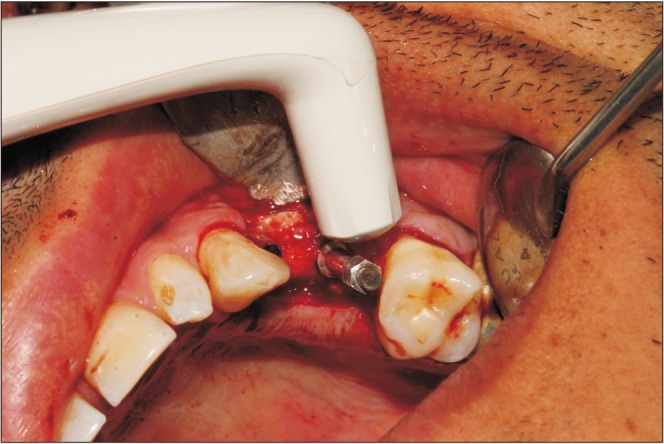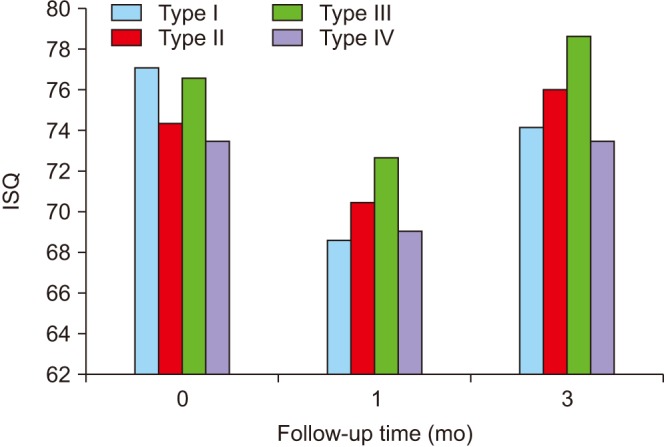J Korean Assoc Oral Maxillofac Surg.
2019 Feb;45(1):29-33. 10.5125/jkaoms.2019.45.1.29.
The evaluation of implant stability measured by resonance frequency analysis in different bone types
- Affiliations
-
- 1Department of Periodontics, College of Dentistry, Mashhad University of Medical Science, Mashhad, Iran. l.khodadadifard@gmail.com
- 2Department of Periodontics, College of Dentistry, Sabzevar University of Medical Science, Sabzevar, Iran.
- KMID: 2461489
- DOI: http://doi.org/10.5125/jkaoms.2019.45.1.29
Abstract
OBJECTIVES
Bone density seems to be an important factor affecting implant stability. The relationship between bone density and primary and secondary stability remains under debate. The aim of this study was to compare primary and secondary stability measured by resonance frequency analysis (RFA) between different bone types and to compare implant stability at different time points during 3 months of follow-up.
MATERIALS AND METHODS
Our study included 65 implants (BioHorizons Implant Systems) with 3.8 or 4.6 mm diameter and 9 or 10.5 mm length in 59 patients. Bone quality was assessed by Lekholm-Zarb classification. After implant insertion, stability was measured by an Osstell device using RFA at three follow-up visits (immediately, 1 month, and 3 months after implant insertion). ANOVA test was used to compare primary and secondary stability between different bone types and between the three time points for each density type.
RESULTS
There were 9 patients in type I, 18 patients in type II, 20 patients in type III, and 12 patients in type IV. Three implants failed, 1 in type I and 2 in type IV. Stability values decreased in the first month but increased during the following two months in all bone types. Statistical analysis showed no significant difference between RFA values of different bone types at each follow-up or between stability values of each bone type at different time points.
CONCLUSION
According to our results, implant stability was not affected by bone density. It is difficult to reach a certain conclusion about the effect of bone density on implant stability as stability is affected by numerous factors.
Figure
Cited by 2 articles
-
Comparison of sandblasted and acid-etched surface implants and new hydrophilic surface implants in the posterior maxilla using a 3-month early-loading protocol: a randomized controlled trial
Hyeong Gi Kim, Pil-Young Yun, Young-Kyun Kim, Il-hyung Kim
J Korean Assoc Oral Maxillofac Surg. 2021;47(3):175-182. doi: 10.5125/jkaoms.2021.47.3.175.Bone loss-related factors in tissue and bone level dental implants: a systematic review of clinical trials
Hamed Mortazavi, Amin Khodadoustan, Aida Kheiri, Lida Kheiri
J Korean Assoc Oral Maxillofac Surg. 2021;47(3):153-174. doi: 10.5125/jkaoms.2021.47.3.153.
Reference
-
1. Farré-Pagés N, Augé-Castro ML, Alaejos-Algarra F, Mareque-Bueno J, Ferrés-Padró E, Hernández-Alfaro F. Relation between bone density and primary implant stability. Med Oral Patol Oral Cir Bucal. 2011; 16:e62–e67. PMID: 20711163.2. Beer A, Gahleitner A, Holm A, Tschabitscher M, Homolka P. Correlation of insertion torques with bone mineral density from dental quantitative CT in the mandible. Clin Oral Implants Res. 2003; 14:616–620. PMID: 12969366.
Article3. Ekfeldt A, Christiansson U, Eriksson T, Lindén U, Lundqvist S, Rundcrantz T, et al. A retrospective analysis of factors associated with multiple implant failures in maxillae. Clin Oral Implants Res. 2001; 12:462–467. PMID: 11564105.
Article4. Park SW, Jang SM, Choi BH, Son HN, Park BC, Kim CH, et al. The study of bone density assessment on dental implant sites. J Korean Assoc Oral Maxillofac Surg. 2010; 36:417–422.
Article5. Turkyilmaz I, Tözüm TF, Tumer C. Bone density assessments of oral implant sites using computerized tomography. J Oral Rehabil. 2007; 34:267–272. PMID: 17371564.
Article6. Ribeiro-Rotta RF, Lindh C, Pereira AC, Rohlin M. Ambiguity in bone tissue characteristics as presented in studies on dental implant planning and placement: a systematic review. Clin Oral Implants Res. 2011; 22:789–801. PMID: 21121957.
Article7. Turkyilmaz I, McGlumphy EA. Influence of bone density on implant stability parameters and implant success: a retrospective clinical study. BMC Oral Health. 2008; 8:32. PMID: 19025637.
Article8. Albrektsson T, Brånemark PI, Hansson HA, Lindström J. Osseointegrated titanium implants. Requirements for ensuring a long-lasting, direct bone-to-implant anchorage in man. Acta Orthop Scand. 1981; 52:155–170. PMID: 7246093.9. Szmukler-Moncler S, Salama H, Reingewirtz Y, Dubruille JH. Timing of loading and effect of micromotion on bone-dental implant interface: review of experimental literature. J Biomed Mater Res. 1998; 43:192–203. PMID: 9619438.
Article10. Makary C, Rebaudi A, Sammartino G, Naaman N. Implant primary stability determined by resonance frequency analysis: correlation with insertion torque, histologic bone volume, and torsional stability at 6 weeks. Implant Dent. 2012; 21:474–480. PMID: 23149504.11. Coutant JC, Seguela V, Hauret L, Caix P, Ella B. Assessment of the correlation between implant stability and bone density by computed tomography and resonance frequency analysis in fresh cadavers. Int J Oral Maxillofac Implants. 2014; 29:1264–1270. PMID: 25397790.
Article12. Kahraman S, Bal BT, Asar NV, Turkyilmaz I, Tözüm TF. Clinical study on the insertion torque and wireless resonance frequency analysis in the assessment of torque capacity and stability of self-tapping dental implants. J Oral Rehabil. 2009; 36:755–761. PMID: 19758410.
Article13. Atsumi M, Park SH, Wang HL. Methods used to assess implant stability: current status. Int J Oral Maxillofac Implants. 2007; 22:743–754. PMID: 17974108.14. Sennerby L, Meredith N. Implant stability measurements using resonance frequency analysis: biological and biomechanical aspects and clinical implications. Periodontol 2000. 2008; 47:51–66. PMID: 18412573.
Article15. Meredith N. Assessment of implant stability as a prognostic determinant. Int J Prosthodont. 1998; 11:491–501. PMID: 9922740.16. Kavita GP, Bansi MB, Rizwan MS. Clinical evaluation of primary stability and osseointegration of endosseous root form implants of different dimensions using periotest. Indian J Appl Res. 2013; 3:281–283.17. Simunek A, Kopecka D, Brazda T, Strnad I, Capek L, Slezak R. Development of implant stability during early healing of immediately loaded implants. Int J Oral Maxillofac Implants. 2012; 27:619–627. PMID: 22616056.18. Han J, Lulic M, Lang NP. Factors influencing resonance frequency analysis assessed by Osstell mentor during implant tissue integration: II. Implant surface modifications and implant diameter. Clin Oral Implants Res. 2010; 21:605–611. PMID: 20666787.19. Martinez H, Davarpanah M, Missika P, Celletti R, Lazzara R. Optimal implant stabilization in low density bone. Clin Oral Implants Res. 2001; 12:423–432. PMID: 11564101.
Article20. Turkyilmaz I, Tözüm TF, Tumer C, Ozbek EN. Assessment of correlation between computerized tomography values of the bone, and maximum torque and resonance frequency values at dental implant placement. J Oral Rehabil. 2006; 33:881–888. PMID: 17168930.
Article21. Ikumi N, Tsutsumi S. Assessment of correlation between computerized tomography values of the bone and cutting torque values at implant placement: a clinical study. Int J Oral Maxillofac Implants. 2005; 20:253–260. PMID: 15839119.22. Friberg B, Jisander S, Widmark G, Lundgren A, Ivanoff CJ, Sennerby L, et al. One-year prospective three-center study comparing the outcome of a “soft bone implant” (prototype Mk IV) and the standard Brånemark implant. Clin Implant Dent Relat Res. 2003; 5:71–77. PMID: 14536040.
Article23. Miri R, Shirzadeh A, Kermani H, Khajavi A. Relationship and changes of primary and secondary stability in dental implants: a review. Int J Contemp Dent Med Rev. 2017; 2017:03011.24. Geckili O, Bilhan H, Bilgin T. A 24-week prospective study comparing the stability of titanium dioxide grit-blasted dental implants with and without fluoride treatment. Int J Oral Maxillofac Implants. 2009; 24:684–688. PMID: 19885409.25. Zhou W, Han C, Yunming L, Li D, Song Y, Zhao Y. Is the osseointegration of immediately and delayed loaded implants the same?: comparison of the implant stability during a 3-month healing period in a prospective study. Clin Oral Implants Res. 2009; 20:1360–1366. PMID: 19793319.26. Degidi M, Daprile G, Piattelli A. Determination of primary stability: a comparison of the surgeon's perception and objective measurements. Int J Oral Maxillofac Implants. 2010; 25:558–561. PMID: 20556255.
- Full Text Links
- Actions
-
Cited
- CITED
-
- Close
- Share
- Similar articles
-
- A comparative study on the initial stability of different implants placed above the bone level using resonance frequency analysis
- Effect of bone quality and implant surgical technique on implant stability quotient (ISQ) value
- Non-submerged type implant stability analysis during initial healing period by resonance frequency analysis
- Relationship between cortical bone thickness and implant stability at the time of surgery and secondary stability after osseointegration measured using resonance frequency analysis
- An evaluation of the primary implant stability and the immediate load-bearing capacity according to the change of cortical bone thickness



